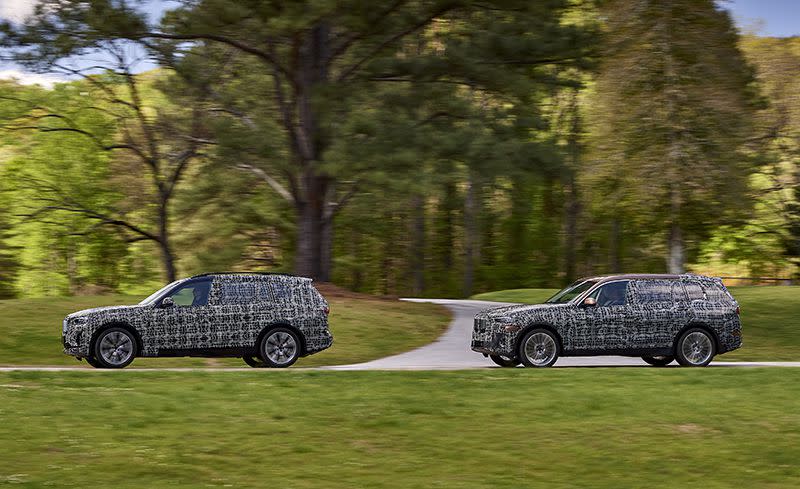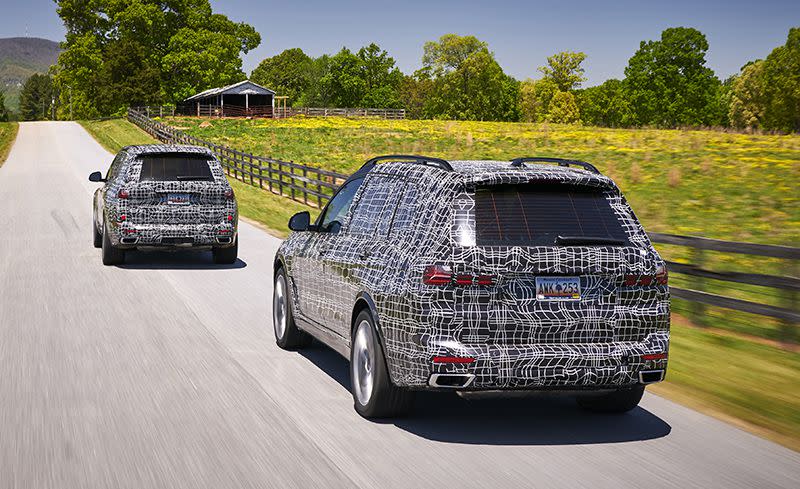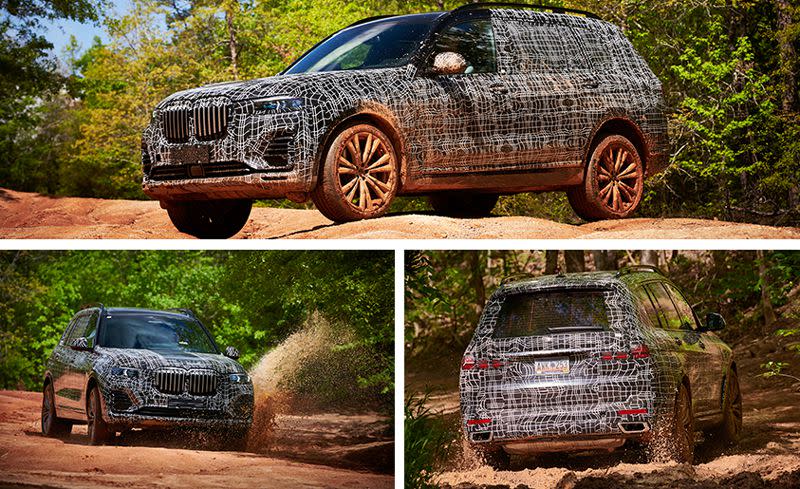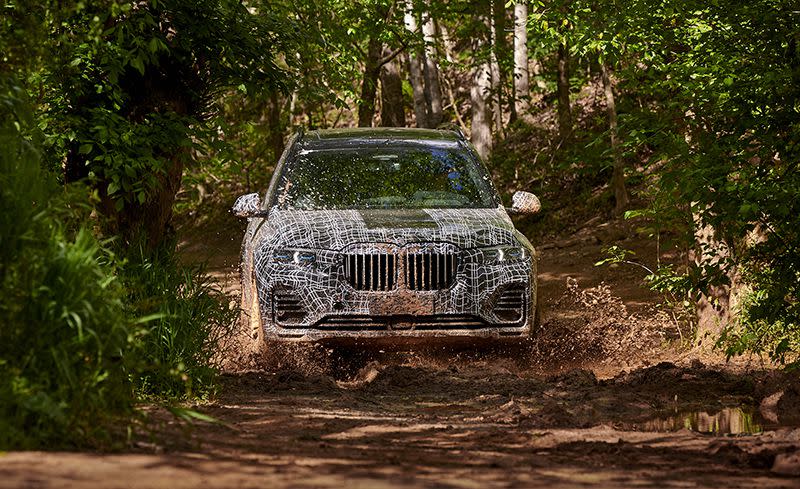We Get Behind the Wheel of the X7, BMW’s Biggest Ever SUV
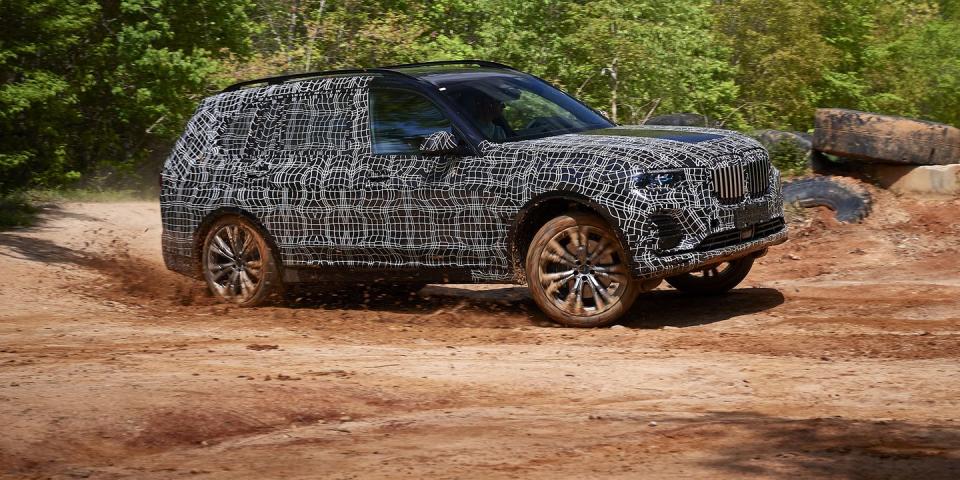
BMW was an early entrant into the luxury SUV market when it introduced the X5 back in 1999. The vehicle was immediately popular, and the brand hustled the smaller X3 to market only four years later. Other luxury brands have since rolled out competing models, and several have branched upward into full-size, dedicated three-row offerings, but BMW dithered on the question of whether to develop an X7. The company busied itself instead with X6 and X4 “coupe” variants of its mainstay models and with the smaller X1/X2. Runaway market demand for SUVs, and the bigger the better-not to mention the success of Mercedes-Benz’s GL/GLS that has been around for more than a decade now-has finally spurred BMW into action. A BMW X7 is now on its way, but it still isn’t here quite yet (expect it to debut this fall and appear in showrooms in the first quarter of 2019), so our first behind-the-wheel exposure to the X7 was in camouflaged prototypes.
The Known and the Unknown
In addition to what the vehicle looks like, there was more that BMW wasn’t quite ready to share regarding the X7: its dimensions, the output of its engines, and the specifics of some of its equipment. Still, our daylong drive, both on the road and off, gave us a good preview of this X model writ larger.
First, the X7 is not merely a stretched X5. It is longer, of course-figure by about seven inches, making it roughly 200 inches from stem to stern-but it’s also wider and taller. That’s evident the moment you walk up to it. The climb aboard is about the same as in an X5, but the view from behind the wheel is not. The dash is wider, and the driver looks out over a hood that appears broad and long. Despite this, you don’t feel lost in the car, thanks to a fairly large glass area, modestly sized pillars, and a businesslike driving position with a prominent dead pedal and a floor-hinged accelerator. The fat-rimmed steering wheel with its sausage-casing-smooth leather wrap is familiar BMW fare, as are the iDrive controller alongside the goofy electronic shifter and the available Multi-contour power seats.
Despite black felt draped about to hide the interior details, the similarities with the current 7-series are evident, with a 12.3-inch central touchscreen standing proud of the dash, below which is a row of climate-control buttons and then eight radio preset buttons and a volume knob. The instrument cluster is also screen based. The wide center console houses the gear selector, the iDrive control knob, and the ignition push button, all of which can be rendered in crystal (fancy!). Additional buttons include those for the standard driving modes, while toward the front of the console is a large covered binnacle that includes two cupholders and additional stowage along with an inductive charging pad for handheld devices.
Moving back to the second row, there is a three-person bench or, optionally, a pair of captain’s chairs. The latter have four-way power adjustment and scoot forward electrically to allow access to the standard third row, which accommodates two. Overhead is a standard panoramic glass sunroof that spans the first two rows; the section above the front seats opens. Above the third row is a separate, fixed glass panel. The second row is plenty comfortable, but if those passengers avail themselves of every last inch of legroom, they’ll leave precious little for their companions back in steerage. Provided some mercy by their second-row counterparts, third-row occupants don’t have it too bad, as there’s decent headroom, the seat cushion is up off the floor to benefit legroom, and the quarter-windows allow a view out.
When not in use, the third row can be power-folded into the floor via buttons in the cargo area. That compartment is accessed through a two-piece hatch, just as in the X5; the larger upper section raises up, and the lower piece drops down. Both actions here are power operated and can be instigated with a foot motion under the bumper. A button at the edge of the open lower tailgate can lower the suspension to ease loading. Don’t expect to fit a lot of chattels with the third-row seat in place, however.
A Pair of Engines
For our market, the X7 will come with a turbocharged 3.0-liter inline-six or a twin-turbo 4.4-liter V-8, as seen in today’s X5. They’re expected to advertise slightly more power and torque than the current 300 horsepower and 300 lb-ft (for the six) and 445 ponies and 480 lb-ft (in the case of the V-8). Both also will be mated to an eight-speed automatic, and xDrive all-wheel drive will be standard. Although the current X5 still offers a diesel engine option, no diesel is planned for the X7 in the United States (other markets will get one); our third powertrain is likely to be a plug-in hybrid (similar to the X5 xDrive40e) but not until the 2020 model year. Oh, and while BMW officials laughed off our queries about an eventual X7 M, that’s not the same as a definitive “No”; Mercedes-AMG does offer a GLS63 after all.
We drove both the six-cylinder and the V-8 on two-lanes and briefly on the highway near Spartanburg, South Carolina, where all X7s will be built alongside their X5/X6 and X3/X4 siblings. Despite the X7’s extra mass compared with the X5 (how much extra BMW isn’t ready to say), the turbo six is perfectly adequate in this application, but its more prominent quality is silence. It’s all but mute, an impression enhanced by the eight-speed automatic’s ultra-smooth shifts. The V-8 proves more charming, though, owing to its effortless acceleration accompanied by an occasional muted rumble.
While we might have predicted the powertrains’ character, we were a little more apprehensive about the chassis tuning, given our disappointment with some recent BMWs, including the current X5. The X7, though, is being developed alongside the next-generation X5 (which actually will beat it to market). The generational improvement is telling. The X7’s steering even in Comfort mode suffers none of the slop or the overly light effort that plagues the X5 that’s on sale today. We can’t comment, however, on the optional Integral Active Steering-rear-wheel steering-since none of the vehicles we drove had it.
All X7s have air springs at all four corners as well as adaptive dampers (BMW’s Dynamic Damper Control). The ride overall is exceptionally comfortable; we might wish for a little less head toss, but body motions are gentle and not pronounced. Switching to Sport mode (the other choices are Adaptive and Eco Pro) didn’t have much of an effect on the proceedings, despite the fact that it lowers the ride height by 0.8 inch. The engineers characterized the chassis tuning as only “80 percent” finalized, however, and one specific tweak they’re looking at is opening up more distance between Comfort and Sport modes; they would do so by making the latter sportier, although they don’t want to create something so firm that owners will never select it.
The roads in South Carolina were hardly the winter-ravaged pavement we’re suffering with back home, but impact harshness over the bumps we did find was minimal. That’s especially notable considering that we were riding on 22-inch wheels with rather absurdly low-profile, staggered rubber sizes: 275/40R-22 up front and 315/35R-22 at the rear (21-inch wheels also are available, with 285/45R-21 tires all around). One of the vehicles we drove was equipped with Active Roll Stabilization (dynamic anti-roll bars) while the other was not, but here again, we were hard-pressed to feel much difference. Hustling along narrow country roads, we found body roll to be well managed-the X7 seems like one seven-seat SUV that’s unlikely to turn your passengers green.
Get Dirty
Gulches Off-Road Vehicle Park, in Waterloo, South Carolina, strikes us as an unlikely destination for a vehicle with a starting price we expect will be north of $70,000, but BMW took us there anyway, since the Germans evidently believe that off-road credibility is still important for a crossover SUV, even a family bus like the X7. The models in which we clambered up and down the red-dirt hills and deep gullies wore the same street tires as the versions we’d been driving on the road, but they were equipped with the optional off-road package. That meant they had an electronically controlled limited-slip rear differential, off-road driving modes, and a larger skid plate protecting the engine, but no additional ground clearance. Still, with the suspension in its max-raised position (1.6 inches above the normal ride height), we were able to make our way carefully along the trails without inducing any expensive scraping sounds, and the standard hill-descent control walked the X7 down steep slopes at single-digit speeds that can be controlled using the up/down cruise-control toggle switch.
Just before heading to the airport the following day, we stopped off at the BMW Car Club of America Foundation, where they were getting ready for a retrospective on the BMW 2002. We walked among pristine examples of that iconic model from almost every year and including the tii, the Baur convertible, and the Turbo. The seminal 2002 sports sedan launched BMW’s reputation in North America, but it is admittedly hard to draw any credible parallels between those lean, minimalist, high-strung machines and the plush, heavy megacruiser that is the new X7. For some, that makes the X7 an apostate against BMW brand values. That opinion is understandable, but we expect that far more fans of the brand will see the X7 as the X5 they know and love, only better suited to family-hauling duty.
You Might Also Like

 Yahoo Autos
Yahoo Autos 